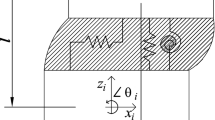Abstract
Aircraft seat ejection systems are essential lifesaving equipment for pilots. Although seat ejections have improved in terms of success rates over the past few decades, ejections at low altitudes (below 150 m) remain a serious concern. These are time critical events and demand optimal process parameters to improve the odds of successful ejection due to the lack of lifesaving height and various other factors. The study optimizes impulse applied and the angle of ejection of the pilot with a novel Multi-Objective optimization approach to minimize Dynamic Response Index (DRI, used to quantify spinal injury) and to maximize the ejection height. The Pareto-optimal solutions are obtained thereof for different scenarios of aircraft flight. A fuzzy logic system is used to handle the uncertainties due to the objective functions under different ejection scenarios of the aircraft; it is used as a decision-maker to choose the initial parameters for goal programming based on the severity of the ejection scenarios. The results were compared with ideal solutions obtained from Pareto fronts using the same fuzzy logic system as decision-maker. The goal programming gave similar results at a quicker time making it advantageous over the conventional “generate first choose later” methods.














Similar content being viewed by others
References
Newman DG (2013) Survival outcomes in low-level ejections from high performance aircraft. Aviation, Space, and Environmental Medicine 84(10):1061
Specker L, Plaga J, Santi V (2001) Ejection seat capabilities to meet agile aircraft requirements. Human Consequences of Agile Aircraft 1
Lewis M (2002) Spinal injuries caused by the acceleration of ejection. J R Army Med Corps 148(1):22
Stech EL, Payne PR (1969) Dynamic models of the human body. Tech. rep., Frost Engineering Development Corp Englewood Co
Ruff S (1950) Brief acceleration: Less than one second. Ger Aviat Med World War II 1:584
Eiband AM (1959) Human tolerance to rapidly applied accelerations: a summary of the literature
Brinkley JW, Shaffer JT (1971) Dynamic simulation techniques for the design of escape systems: current applications and future air force requirements. Tech. rep., AIR FORCE AEROSPACE MEDICAL RESEARCH LAB WRIGHT-PATTERSON AFB OH
USAF (2016) Mil-hdbk-516cn-56. Tech. rep.
Wei Z, Jingheng W, Dongqi M (2015) Optimum research of control law in hty-x of ejection seat
Sadler R, McCauley D (2005) Propulsion’s contribution to the success of aircrew emergency escape systems. In: 39th AIAA/ASME/SAE/ASEE joint propulsion conference and exhibit, p 4966
Carroll J (1983) Control law design for ejection seats. In: Guidance and control conference, p 2204
Wise KA, Brinker JS (1996) Linear quadratic flight control for ejection seats. Journal of Guidance, Control, and Dynamics 19(1):15
Deb K, Pratap A, Agarwal S, Meyarivan T (2002) A fast and elitist multiobjective genetic algorithm: NSGA-II. IEEE Trans Evol Comput 6(2):182
Abdullah L (2013) Fuzzy multi criteria decision making and its applications: a brief review of category. Procedia-Social and Behavioral Sciences 97:131
Yang X, Cao X (2015) A new approach to autonomous rendezvous for spacecraft with limited impulsive thrust: based on switching control strategy. Aerosp Sci Technol 43:454
Wang W, Peng H (2017) A fast multi-objective optimization design method for emergency libration point orbits transfer between the sun–earth and the earth–moon systems. Aerosp Sci Technol 63:152
Messac A, Mattson CA (2002) Generating well-distributed sets of Pareto points for engineering design using physical programming. Optim Eng 3(4):431
Charnes A, Cooper WW, Ferguson RO (1955) Optimal estimation of executive compensation by linear programming. Management Sci 1(2):138
Romero C (2014) Handbook of critical issues in goal programming. Elsevier, Amsterdam
Gembicki F (1974) Vector optimization for control with performance and parameter sensitivity indices, Ph. D. thesis, Case Western Reserve Univ.
Payne PR (1962) The dynamics of human restraint systems. Impact Acceleration Stress, pp 195–257
Latham WCF (1957) A study in body ballistics: seat ejection. Proceedings of the Royal Society of London. Series B-Biological Sciences 147(926):121
Robinson G, Jovanoski Z (2010) Fighter pilot ejection study as an educational tool. Teaching, Mathematics and its Applications: International Journal of the IMA 29(4):176
MATLAB (2017) version: 7.10.0 (R2017b) (The MathWorks Inc., Natick, Massachusetts
Wang YF, Chen G, Han LL (2014) The comprehensive survey for the numerical simulation of the 4th generation rocket ejection seat thrust vector control system. In: Applied mechanics and materials, vol 551, pp 523–529
Specification P (1996) Seat system, upward ejection, aircraft, general specification for. Tech. rep. MIL-PRF-9479d (USAF)
Raj RN, Shankar K (2019) A multi-objective optimization study of parameters for low-altitude seat ejections. In: Soft computing for problem solving. Springer, pp 311–325
Zadeh LA, et al. (1965) Fuzzy sets. Inform Control 8(3):338
Kalavsky P, Socha V, Socha L, Kutilek P, Gazda J, Kimlickova M (2015) Conditions for abandonment out of a helicopter using personal rescue parachute. In: 2015 International conference on military technologies (ICMT). IEEE, pp 1–5
U.S.O. of the Chief of Naval Operations, U.S.N.A.S. Command, NATOPS Flight Manual: Navy Model AV-8B Aircraft 161573 and Up (The Command, 2008). https://books.google.co.in/books?id=7WguHQAACAAJ
U.S.O. of the Chief of Naval Operations, NATOPS Flight Manual: Navy Model F/A-18E/F 165533 and Up Aircraft (Naval Air Technical Data and Engineering Services Command, Naval Air Station, North Island, 2001). https://books.google.co.in/books?id=Ol2jYgEACAAJ
Kal’avskỳ P, Gazda J, Kimličková M (2015) Emergency bail-out from aircraft landing with personal rescue parachutes. Acta Avionica 17(1)
USAF (2007) Mil-dtl-9479 rev. e. Tech. rep.
Mao XD, Lin GP, Yu J (2011) Predicting ejection velocity of ejection seat via back propagation neural network. J Aircr 48(2):668
Author information
Authors and Affiliations
Corresponding author
Additional information
Publisher’s Note
Springer Nature remains neutral with regard to jurisdictional claims in published maps and institutional affiliations.
Rights and permissions
About this article
Cite this article
Raj, R.N., Shankar, K. Multi-objective Goal Programming for Low Altitude Seat Ejections with Fuzzy Logic–Based Decision-making. Hum Factors Mech Eng Def Saf 4, 6 (2020). https://doi.org/10.1007/s41314-019-0031-7
Received:
Revised:
Accepted:
Published:
DOI: https://doi.org/10.1007/s41314-019-0031-7




